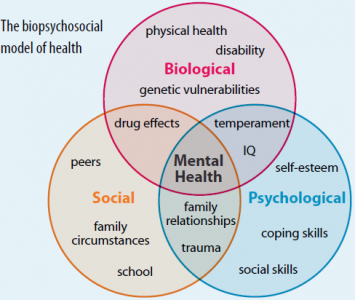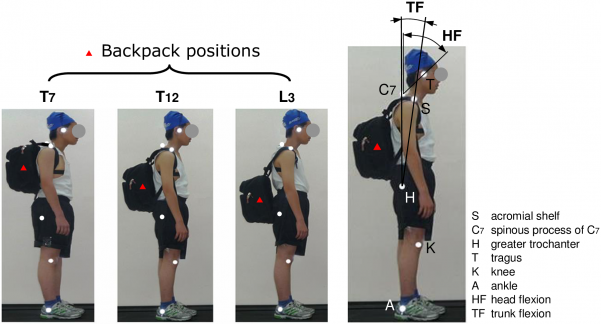Backpack Carriage and Low Back Pain in Schoolchildren and Adolescents
Overview[edit | edit source]
- Physiology of schoolchildren and adolescent spine
- Low back pain & prevalence in younger population
- Anatomy of paediatric spine
- Backpack trends
- Biopsychosocial model
- Relationship between backpack carriage and back pain
- Explore into backpack load, load position and carriage style
- Conclusion
- Relevance to physiotherapy
- Areas for further research
Anatomy[edit | edit source]
Paediatric and adult spine differences:
- Increase cartilage/ bone ratio.
- Presence of soft tissue elasticity, muscle weakness and incomplete ossification means greater ROM available.
- Vertebral bodies in paediatric spine are partly cartilaginous.
- Intervertebral disc spaces are larger, and are well hydrated.
- Vertebral apophyses develop at the inferior and superior surfaces of the vertebral bodies. These appear by 5 years of age and fuse by 18-20.(Doormans, 2004)
Low Back Pain (LBP)[edit | edit source]
- Low back pain is not a disease but a collection of symptoms (Ardakani, Leboeuf-Yde and Walker, 2018)
- Pain limited to the region between the lower margins of the 12th rib and the gluteal folds (Anderson, 1977)
- LBP can be classified into two types; non-specific and specific
- LBP can be further characterised into three subtypes: acute, subacute and chronic (Maher et al., 2017).
Prevalence[edit | edit source]
- Major health issues with a lifetime prevalence of 80%
- Prevalence rate would increase with age (16% for children and 58% for adolescents) (Calvo-Muñoz, Gómez-Conesa and Sánchez-Meca, 2013).
- Self-reported prevalence of back pain was 27%, 37% and 47% among children aged 11, 13 and 15 years, respectively (Yamato et al., 2018).
- The estimated annual cost of chronic low back pain in adolescents aged 10-17 in the US was $19.5 billion (Groenewald et al., 2014).
Aetiology[edit | edit source]
There are four main categories of risk factors associated with low back pain in children and adolescents: anthropometry, psychological and biomechanical factors and lifestyle (Jones, 2005; Yamato et al., 2018)
Trends[edit | edit source]
- Most common way - 2 straps
- Carriage styles: 2 straps/ 1 strap/ wheeled
- (Abdul Sahib, 2016)
- Variation regarding recommendations for children and adolescents carrying schoolbags.
- 10% of their body weight load as proposed (Voll and Klimt, 1977)
- Safe loads are mostly within 10%–15% of body weight (BW) range but include values as low as 5%14 and as high as 20%.
(Yamato et al., 2018)
Biopsychosocial Model[edit | edit source]
The biopsychosocial model proposed by George Engel in 1977 highlights the significance of taking on a medical care path that not only considers the biological aspects of medicine, but also the psychological and social dimensions of a patient[1]. This model implies that behaviours, feelings and thoughts may influence a physical state[2].
Common occurrence of non-specific back pain in schoolchildren and adolescents has led to research exploring into mechanical and physical factors that could possibly explain why such phenomenon occurs[3]. Over the years, it has been thought that external mechanical load of a backpack is one of the major factors that contribute to back pain in children and adolescents[4]. This page will explore into the relationship between backpack carriage and low back pain in schoolchildren and adolescents. Furthermore, the psychosocial factors will also be considered.
Backpack Carriage[edit | edit source]
Backpack Weight[edit | edit source]
Back pack weight has traditionally been postulated to increase the risk factor for eliciting low back pain, despite no high quality evidence supporting this claim. A recent systematic review aiming to identify this relationship found there to be very little evidence to suggest the relationship is positive. Of the studies supporting the claim, all were of moderate to low quality.
Backpack Load Position[edit | edit source]
In addition to the load of the backpack weight, literature have stated that the position of a backpack may also influence the efficiency of posterior load carriage [5]. Efficient load carriage is associated with minimal energy expenditure and minimal anti-gravity stress on spinal tissues, and is believed to occur when an individual is in an unloaded state, where the anatomical body is aligned with the vertical reference closely [5][6]. Application of external load to the body is commonly associated with deviation of the spine (posture affected at times), away from the gravitational axis, which is believed to be a cause of spinal pain [6].
Limited research has been conducted examining specifically on the relationship between low back pain and the effects of backpack load position, especially in schoolchildren and adolescents. A randomised crossover trial published in 2018, examined the effects of backpack load and position on body strains in male schoolchildren [7]. It examined three different load positions, where the midline of the backpack was at either T7, T12 or L3 spinous process level. where From the results, the study had recommended to place centre of backpack at T12 level to reduce discomfort and to avoid a less fixed upper body. However, the limitations to this study is that it was conducted in a male-sex only population and had a a small sample size of 10 (unpowered) participants. Therefore, it is difficult to generalise these findings. Larger study groups are needed in future studies to increase external validity.
Backpack Carriage Style[edit | edit source]
There is limited contemporaneous evidence investigating the impact of backpack carriage method on low back pain. Evidence suggests that when a backpack is carried on one shoulder, this may lead to a potential change in the spine as the spine may side flex in order to compensate for the load (Drzał-Grabiec et al., 2014). This may result in the inflammation of supporting structures of the spine such as joints, muscles and ligaments due to spinal curvature or muscle spasms (Allegri et al., 2016).
- A literature review summarised there was inconsistent evidence to show the relationship between backpack carriage method and back pain in children and adolescents. However, the nature of a literature review is of low level of evidence (Abdul Sahib, 2016).
- A recent systematic review stated that only 3 out of 29 cross-sectional studies found an association between the method of backpack carriage and backpack. However, limited information of the study was provided (Yamato et al., 2018).
Conclusion[edit | edit source]
- No convincing evidence to show backpack use increase the risk of back pain
- No clear association between backpack characteristics (weight, style and strap length) and back pain.
- Good evidence to suggest psychosocial factors or distress may have an impact on back pain in children and adolescents (Kamper et al., 2016)
Relevance to Physiotherapy[edit | edit source]
- Provide advice and education on backpack carriage and beliefs
- The bigger picture:
- Consider and explore into psychosocial factors in patients with back pain who are under 18 e.g. stress
- Consider lifestyle risk factors e.g. smoking, weight
Areas for Further Research[edit | edit source]
- Higher quality of evidence required
- High quality study design to increase generalisability
- Further research on the impact of psychosocial factors on back pain in schoolchildren and adolescents
References[edit | edit source]
<references />
- ↑ Smith R. The biopsychosocial revolution. Journal of General Internal Medicine. 2002;17(4):309-310.
- ↑ McInerney S. BMJ 2018;324:1533 Introducing the Biopsychosocial Model for good medicine and good doctors. BMJ [Internet]. 2018 [cited 18 May 2018];. Available from: https://www.bmj.com/rapid-response/2011/10/29/introducing-biopsychosocial-model-good-medicine-and-good-doctors
- ↑ Watson K, Papageorgiou A, Jones G, Taylor S, Symmons D, Silman A et al. Low back pain in schoolchildren: the role of mechanical and psychosocial factors. Archives of Disease in Childhood. 2003;88(1):12-17.
- ↑ Reneman M, Poels B, Geertzen J, Dijkstra P. Back pain and backpacks in children: Biomedical or biopsychosocial model?. Disability and Rehabilitation. 2006;28(20):1293-1297.
- ↑ 5.0 5.1 Devroey C, Jonkers I, de Becker A, Lenaerts G, Spaepen A. Evaluation of the effect of backpack load and position during standing and walking using biomechanical, physiological and subjective measures. Ergonomics. 2007;50(5):728-742.
- ↑ 6.0 6.1 Grimmer K, Dansie B, Milanese S, Pirunsan U, Trott P. Adolescent standing postural response to backpack loads: a randomised controlled experimental study. BMC Musculoskeletal Disorders. 2002;3(1).
- ↑ Chen Y, Mu Y. Effects of backpack load and position on body strains in male schoolchildren while walking. PLOS ONE. 2018;13(3):e0193648.








